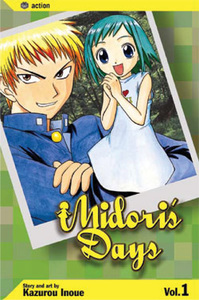Review
by Carlo Santos,Midori's Days
(Midori No Hibi)
| Synopsis: |  |
||
Seiji Sawamura is the toughest guy at Sakuradamon High—and because of his fearsome attitude, every girl that he's ever asked out has rejected him. At age 17, Seiji is now extremely concerned that his only "girlfriend" will be his right hand. Imagine his surprise, then, when Seiji wakes up from a nap to find out that his right hand has turned into a very small girl! And not just any girl—Seiji's new appendage is Midori Kasugano, a student who's secretly had a crush on him for years. Will Seiji ever get his right hand back? More importantly, how will he carry out his daily activities? |
|||
| Review: | |||
Every now and then, a story idea comes along that makes everyone go "NO WAY. That's just WRONG." Midori's Days (or Midori No Hibi, as it was originally called) is built on that sort of idea, and it's easy to dismiss it as a gimmicky manga that runs out of steam as soon as the joke wears off. Against all expectations, however, the series hits its stride once we get used to the right-hand girlfriend gag—and evolves into an ingenious, character-driven comedy with a light love story woven into it. Midori's Days isn't exactly going to transform shounen romantic comedy, but with the genre having fallen into a fanservice-induced stupor, a work that's this charming and clever is sure to make readers sit up and take notice. At eight volumes long, don't expect Midori's Days to be a sweeping epic. The story is an easy one to latch on to, with high-school romance providing the foundation—but given a premise as kooky as this, playing the romance for laughs is inevitable. If you think Kazurou Inoue is pretty creative for coming up with this manga, just wait until you see the situations that he tosses Seiji and Midori into. Even something like going to the bathroom becomes hilarious, with Seiji's over-the-top attitude being the perfect catalyst for comedy. The staccato, 16-page-per-chapter pacing also boosts the energetic style of this manga; most every page is a showcase for Inoue's endless parade of humor, be it visual gags, embarrassing situations, or sheer absurdity. It isn't just the laughs that propel Midori's Days, however. Though the first few volumes of the manga follow a somewhat repetitive sitcom format, there are already traces of a continuous story that eventually takes center stage in the middle and later volumes. Once the dynamics between Seiji and Midori are established, studious schoolgirl Takako Ayase—who normally can't stand Seiji—finds herself drawn to him ever since he "injured" his hand and toned down the tough-guy act. Ayase's attempts to win Seiji add even more humor to the mix, but there are also serious emotions at play, and the tender moments can be just as impactful as the hilarious ones. This manga will make you laugh hard and loud, but don't be surprised if the final volume triggers a few tears as well. Like all great comedies, this manga's outrageous sense of humor comes from a memorable cast of characters. Besides Seiji, Midori and Ayase, we have Takamizawa, a figurine otaku who thinks Midori is a hand puppet; Miyahara, Seiji's right-hand man and easy bait for rival school gangs; Nao, a mysterious wide-eyed girl who develops a crush on Midori; Rin, Seiji's domineering sister and the only person who can beat him up—and that's just some of the more commonly recurring characters. There's also Kouta, Midori's former classmate and would-be suitor who finds himself falling in love with Seiji... resulting in a one-sided gay relationship that's notable for its total lack of yaoi clichés. Many of Seiji's interactions with these characters are downright hilarious, but there are also moments of surprising depth. As Midori's presence wears away Seiji's thuggish attitude, he gradually learns that friendship is worth far more than fear. The clean, dynamic visuals of Midori's Days are another driving force behind the manga's rapid-fire humor. Although it often looks like Inoue is "drawing for the anime"—i.e., making the characters easily adaptable to the screen—the artwork still uses comedic techniques that are well suited to manga. For example, Inoue deftly switches styles into high-contrast, heavily hatched realism when he wants to exaggerate Seiji's "Yankee" nature, or lays on ridiculous amounts of screentones and sparkles when someone is having a flowery shoujo dream sequence. The most effective visual gags, however, have to be the outrageous facial expressions that come up repeatedly throughout the series. If it's not Seiji yelling at Midori, then it's Midori being totally aghast at Seiji's porn collection, or maybe Takamizawa drooling over the "most realistic hand puppet ever"—it's these techniques that make the characters real. The lively, almost hyperactive artwork of Midori's Days will captivate the reader both with its style and storytelling. It's a rare and talented manga-ka who can create a story that's imaginative, hilarious, and touching all in one. Kazurou Inoue does exactly that, and in doing so sets a standard in comedy manga that future creators will have to keep in mind. Midori's Days may be too cutesy or out-there for some readers, but the ingenuity and craft that went into it is undeniable. North American readers can expect this on the shelves in a few months, probably accompanied by the mutterings of "NO WAY. That's just WRONG." Yet everything in it is just about right. |
|
The views and opinions expressed in this article are solely those of the author(s) and do not necessarily represent the views of Anime News Network, its employees, owners, or sponsors.
|
| Grade: | |||
Overall : A-
Story : B+
Art : A
+ Unforgettable characters and ingenious situations make for a delightful laugh-out-loud comedy |
|||
| discuss this in the forum (14 posts) | | |||
| Production Info: | ||
|
Full encyclopedia details about |
||